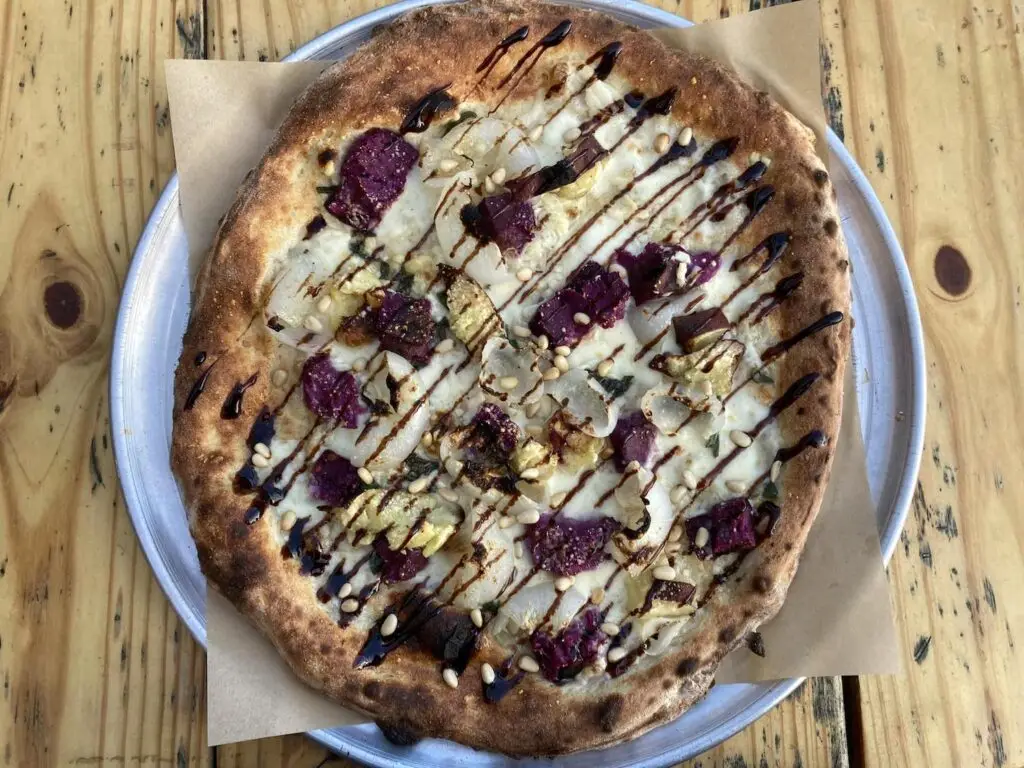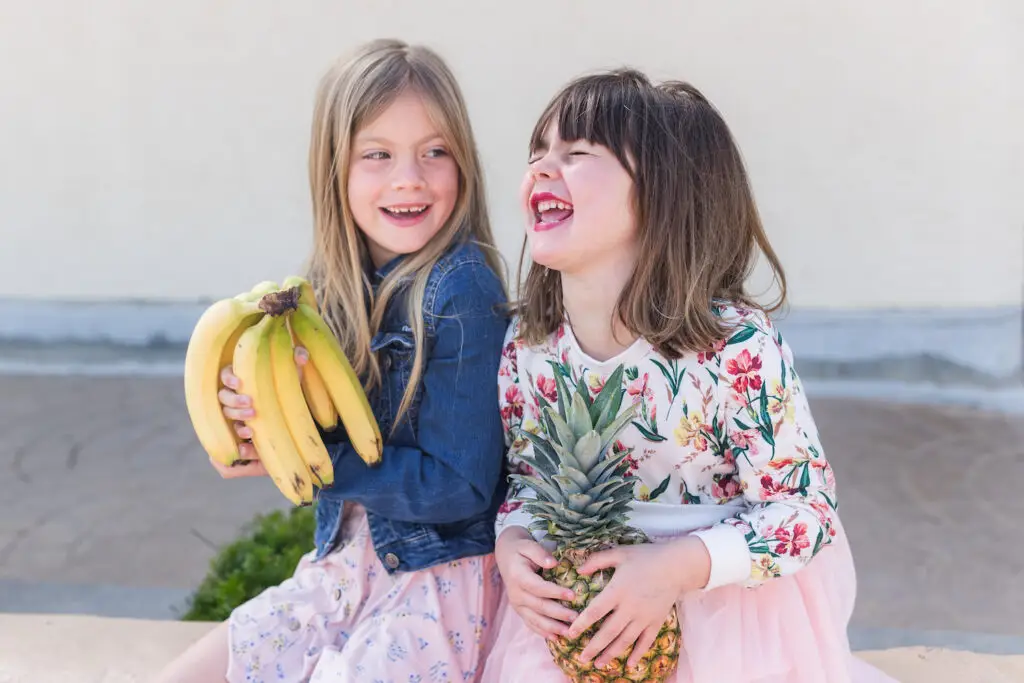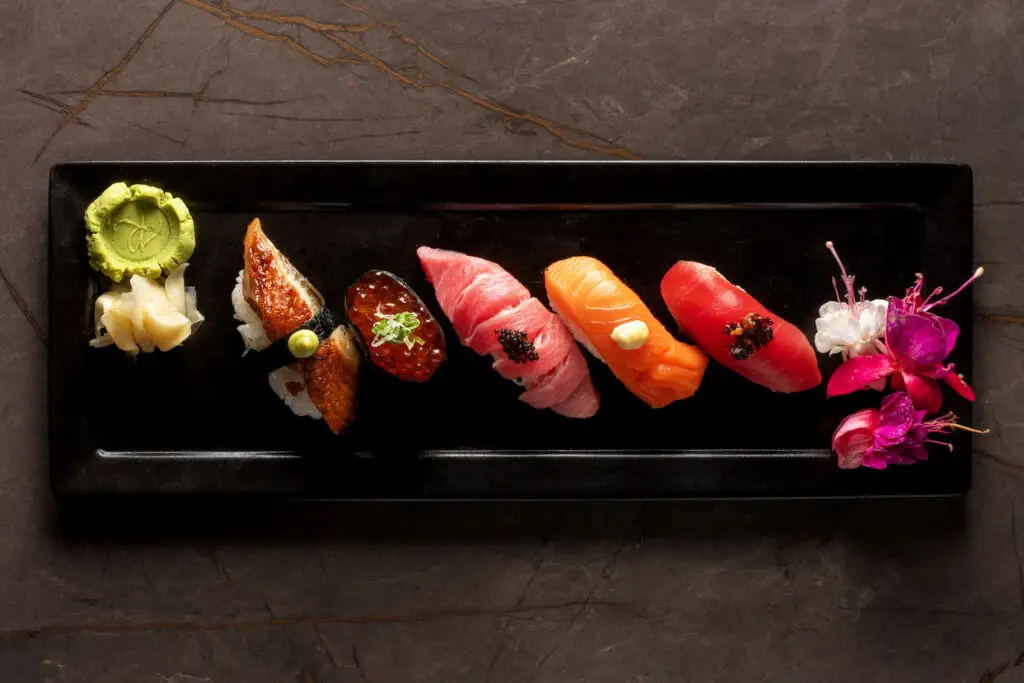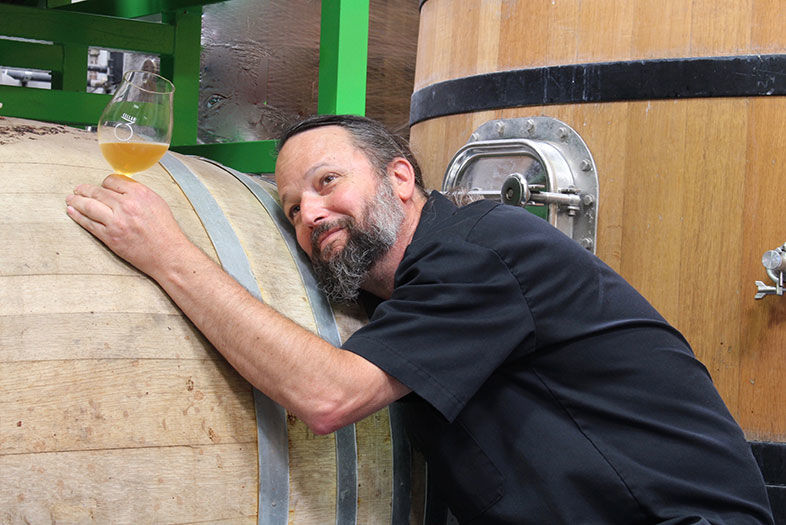When he’s feeling particularly humble, Pat Korn will tell you that he’s really just a glorified babysitter. But the real truth is that he’s charged with overseeing the most unpredictable kind of brewery program—one that requires more complex procedures to accomplish, is fraught with potential failure at every stage, but has the potential to produce absolute magic.
Pat Korn is the barrelmaster at Cellar 3, which is Green Flash’s exclusively barrel-centric production facility in Poway. There, he has four huge foeders (large oak vessels that each hold 50 barrels of beer) in production, in addition to about 1,000 barrels in constant use. While most brewers can enjoy their finished products after only weeks in a tank, Pat must be at peace with the fact that his creations take months—often years—to become ready. For his patience, he is richly rewarded, for most of the beers that pour from the barrels at Cellar 3 have undergone transformations that cannot be replicated or substituted with anything else. Time is the only way to do it.
I sat down with Pat to talk about the aspects that make being a barrelmaster unique. As I sipped and savored an amazing Fresco Sauvage (brett-barrel-aged saison that had been dry-hopped with Simcoe and Citra), Pat told me about the specific challenges of barrel-aging, his vision for getting away from spirit-barrel beers, and the ultimate beauty of uncertainty.
So, looking toward the future, you’ve said that you’re trying to get away from the spirit-barrel-aged beers. Is that right?
Yes. We’ve done the experiments. We’ve done gin. We’ve done tequila. We’ve done different tequilas. We’ve done mezcal. We’ve done different rums. We’ve done different bourbons. They were cool, but we’re moving beyond that—the biggest reason being that the quality of the barrels has significantly dropped. We had problems with Silva Stout contamination and we’re not the only ones. Goose Island had problems with their barrels, I thought I heard something about Deschutes having infected Abyss barrels…
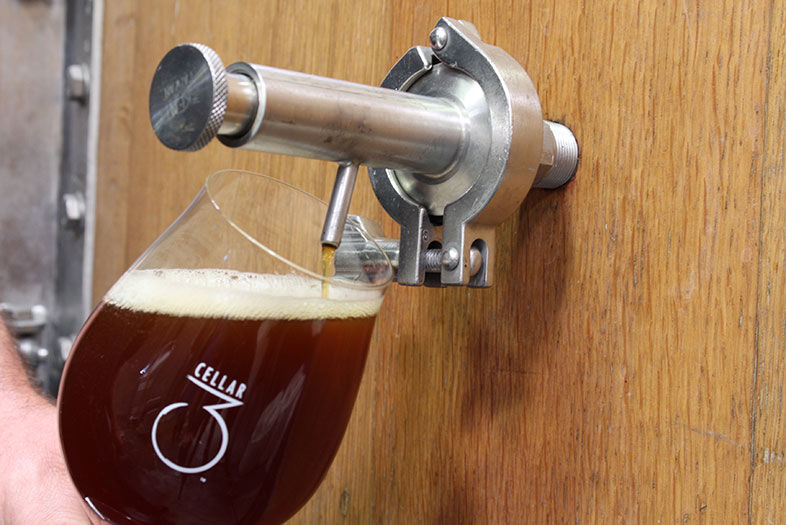
Have a Beer with Cellar 3 Barrelmaster Pat Korn
A Flanders-style red pours from one of Cellar 3’s giant foeders. | Photo: Bruce Glassman
What accounts for that, do you think?
Here’s the biggest thing: Five years ago barrels were pretty plentiful. Distilleries would use them once—they can’t re-use them for bourbon, they can only use them once. Those guys are not making whiskey or whatever else, so they would send them out, mostly to Scotland, where they all got used. When I first took over the barrel program, I would get barrels and they would still have a pint of liquor in them. What they’re doing now is they’re re-filling them with water to get that little bit out, and then they’re re-distilling that water. I’ve talked to other barrel people and they’ve had the same problems and they believe this is what’s going on. Maybe it’s bullshit, but the ones we got last time were bone dry.
Does this only happen with bourbon barrels, or is it true with the other barrels as well?
All the other barrels we’ve gotten have come completely dried out. You know, you have this kind of grandiose idea when you’re buying these things; I really thought a tequila barrel would show up and it would be, like, something amazing. But it’s pretty much just an old bourbon barrel that got sent to a second-or-third-world country where it was used for however long. And you don’t get the barrels from here; they’re picked up and put on a boat to somewhere, and then they’re sent back here—maybe in a shipping container that was sitting in Long Beach on the dock for two months. Before, if you had a barrel that had 120- or 130-proof liquid in it, nothing’s going to grow in there. But if you empty it out and there’s water in there and you leave it on a dock somewhere, it’s a perfect breeding ground. So, long story short: We’ve done the experimentation in the last two to three years and now we’re moving on. To be honest, I enjoy drinking bourbon-barrel stouts and the like, but as far as making them, it’s kind of one-dimensional to me. You can’t really blend— I mean you can, but I find it to still be one-dimensional.
You can blend it, but it’s really just to be more or less boozy or bourbon-y, right?
Exactly. We do have about 150 of those barrels in use right now. They were Silva Stout barrels, but we don’t make that beer anymore. We now make Lustrous Frumento, and we don’t add any fresh beer to it. It’s just 100% bourbon-barrel aged. And probably once we get through those, we’ll go back to just doing the small batches.
And you’ll focus your barrel program more on wine barrels?
Yes.
Barrels from all of the various kinds of wines, I would imagine. Whites and reds?
We have done some white wine barrels in the past. I only buy barrels from five or six winemakers; they’re friends of mine, I really like their wines, and they’re all GSM barrels [Grenache/Syrah/Mourvedre], either individual or blends of them. I just found that the beers we’re making taste really good in those barrels.
What kinds of beers do you feel do the best in the GSM barrels?
Any of the Natura Morta beers we’re doing. We’re doing Le Freak, which is now called Vivid Sauvage. And we’re also conditioning what’s called Divine Sauvage—it used to be called Brett Barrel Trippel—aging in red wine barrels. So, for us, the whole basis of what we’re doing here is this: We’ve always made this core group of beers—we’ve always made Saison, we’ve made Le Freak, we’ve made Trippel, we made the double stout—these were beers that we knew through and through. By manipulation—adding wild yeast or micro flora or different barrels—we try to transform those beers into something completely different. It sounds weird—I’ve been doing the barrel program now for five years—and I’m finally at the point where I know what works and what doesn’t, so this is where we’re going to move to. And we’re going to do it by working with a great team. I have Erik Jensen, our brewmaster, who’s a great brewer—and a great theoretical brewer—and I also have Kevin Barnes (our head brewer in Mira Mesa), Evan Chamberlain over in Virginia Beach, and Sean [McIlhenney] up in Alpine. These are guys I can really bounce stuff off of. We’ve all been brewing long enough to know what does and doesn’t work.
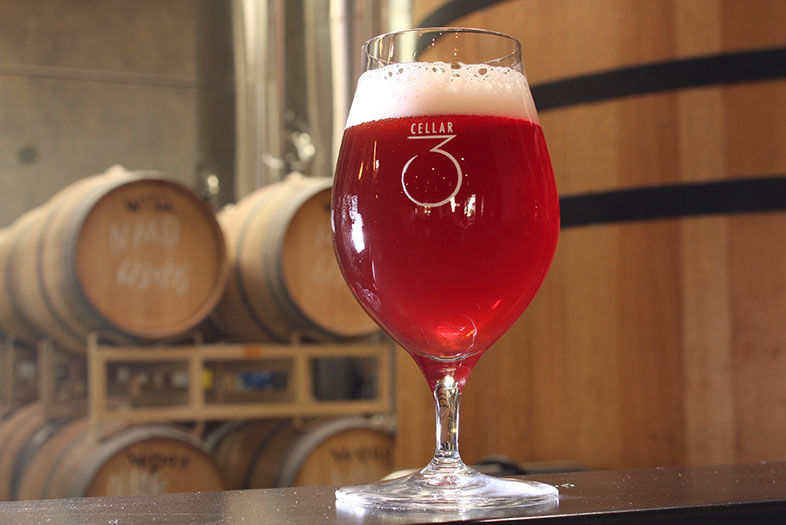
Have a Beer with Cellar 3 Barrelmaster Pat Korn
Natura Morta is a collection of American Wild Ales that are each augmented with some kind of fruit. | Photo: Bruce Glassman
Can I assume that you get more satisfaction, as a barrel guy and a brewer, doing beers like this Fresco Sauvage, which is a lot more complex and has a lot more going on, than the typical bourbon-barrel-aged stuff? This beer is actually a lot like a wine.
Yeah. To be honest, there are some very core things I’m trying to do here. It sounds sort of stupid or simplistic—but there’s a flavor that I have in my head that I want in the glass, and we just kind of work our way backwards from there. I do want to bring out those vinous qualities in the beer. I love wine, I drink a lot of wine—I actually drink more wine than I do beer. So I guess I’m just trying to take the beer further, trying to add more wine-like qualities to it.
Do you find a lot of people down in the tasting room who say they don’t like beer but they like this?
Yes.
It’s a good bridge between beer and wine.
And we have enough different alcohols and flavors and bases for the beer, that you can pretty much find something that you’re going to like to drink. If someone tells me they like Sauvignon Blanc, then this beer would be great. Someone who likes Pinot Noir could drink the Vivid Sauvage with black currant—it tastes like an Italian field blend.
Tell me about some of the unique challenges that you face as a barrelmaster, as opposed to regular production brewing (which has plenty of challenges as well).
Probably the biggest challenge is the fact that the most predictable thing about this is that it can be unpredictable.
Right. Whenever people think about working with barrels they assume that the whole thing is very unpredictable. Is it really as unpredictable as people think?
For me, no. But I have the support and the funds and the equipment that a lot of other people don’t have. That’s the one thing I’ll say about Green Flash as it relates to Cellar 3: From day one it was utter support. Mike Hinkley said, “I completely trust you.” So I’ve been really lucky with that. The biggest thing for me in this is—if you’re going to do it on this kind of scale—one of the biggest things you have to do is “Serenity Now.” You just have to, because at any moment everything could just go to shit and you have to be able to just accept that. Now, do I think that’s going to happen? No. I know that’s not going to happen, but failure is an absolute option.
Do you feel sort of like you’re taking a bigger risk for a bigger potential reward?
That’s maybe a small part of it, but every brewery runs a risk, I just take a little higher one because I’m using wild yeast. It took me a little bit of time to accept that risk. I’ve found that you just have to let the beer do its thing. There are times when I’ll put beer in barrels and I won’t touch it for six months because there really is no reason to. And you have to know that it goes through phases. You’ll try it one week and it’s the greatest beer ever and the next week you’re saying, “Man, I’m gonna dump this.” So you just have to have the attitude that you did the best you could. We’re very contemplative here, but when we make our decision, we do it and we don’t look back.
Are there other specific challenges to barrel aging?
Well, sometimes it’s tough when I tell people in the company that the beer is going to be ready on a certain date and then it’s not ready for another three months and they say, “You can’t do this!” I have to tell them all the time that I babysit. These barrels are going to do what they want to do and my job at the end is to take what’s in the barrels and get back to what I think it should taste like.
One of the Holy Grails for all brewers is consistency, right? I mean, you have one or two beers that people love and every time they come in for that beer, you want it to taste exactly the same. You don’t really have that luxury, do you? Each batch is going to taste different to some extent, right?
Yeah, each batch is going to taste different. But I think I can make each batch every year and have it be close to what I think it should be. I mean, for me, I would like every batch to taste exactly the same every time, but that’s never going to happen. I really try to take many of the ideals of linear brewing and incorporate them into what we’re doing and try to find a sort of “sweet spot.” We haven’t found it yet. There are things that they do over in Mira Mesa that just don’t translate. But, if my beer tastes a little bit different every time, well, there’s a certain beauty in that. Every time you drink a Cantillon it doesn’t taste the same, and that’s kind of the beauty of this whole thing.
And most brewers, when they put together a recipe, can pretty much take full credit for every aspect of that beer. Like a chef, they’ve used this ingredient and that ingredient in a very specific proportion. You do that, but you have this one extra element, which is the element of unpredictability that plays a role.
Yes. It’s an amazing thing. And what’s really great for me is that it’s taken us years to get to a point where I can take that element and create beers that taste exactly like I want them to. Personally, I think I probably have the greatest brewing job in San Diego.
Mark Your Calendar: Cellar 3 will celebrate its 2nd Anniversary this Sunday, May 21, from 12 to 5 p.m. The public is welcome to join the festivities, which will include a birthday cake cutting, a beer and cheese tasting, live music from The Barnacles, and will feature some notable beer releases, including Lustrous Frumento aged on Luxardo Cherries (I wangled a sneak taste and it’s amazing!). Various other Lustrous Frumento casks will be tapped, some of which have been augmented with special flavorings like mint, vanilla, sea salt, or caramel; Divine Frumento which is a bourbon-barrel-aged Trippel; and Raisin the Bar which is collaboration with Alpine, in addition to Process of Belief, an Alpine framboise.
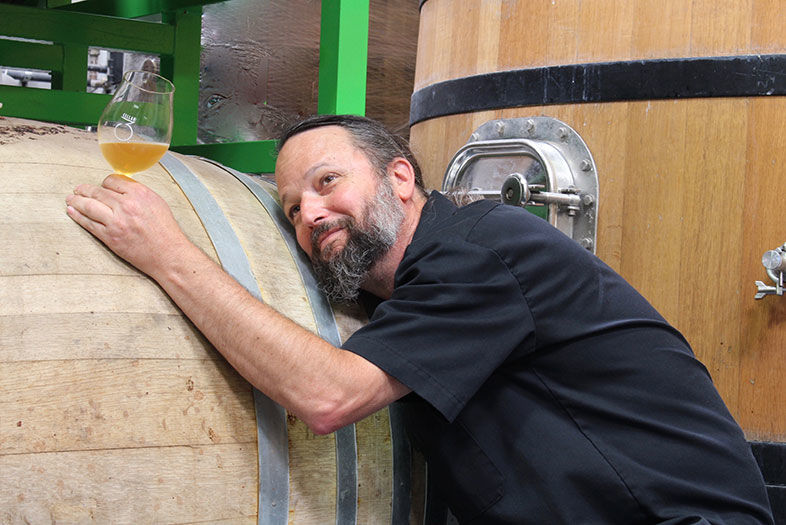
Have a Beer with Cellar 3 Barrelmaster Pat Korn
PARTNER CONTENT
Pat Korn is the “Barrel Whisperer” at Cellar 3. | Photo: Bruce Glassman
